![Paul Thomas Minnihan, I Dare to Dream, 3353 W 13th St [Black Neighborhood], Chicago, 1995.jpg Paul Thomas Minnihan, I Dare to Dream, 3353 W 13th St [Black Neighborhood], Chicago, 1995.jpg](https://486312.frmmmguz.asia/files/square_thumbnails/b2254bc5fe1b092ee4f9c95af8c1ebf3.jpg)
I Dare to Dream
I Dare To Dream is a Chicago mural painted in 1995 by artist Paul Thomas Minnihan. Drawing heavily upon local history, the mural includes locals such as the Chicago Bulls player Michael Jordan, astronaut and first African American woman to travel into space, Mae C. Jemison, and Harold Washington, the first African American mayor of Chicago. Alongside the Chicago figures are the faces of Mary McLeod Bethune, Frederick Douglass and Martin Luther King Jr. The west side mural was situated opposite the Douglass Branch of the Chicago Public Library, but no longer exists.
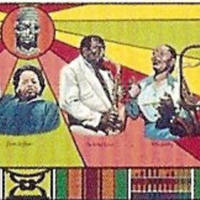
Baltimore Wall of Pride
The Baltimore Wall of Pride stands in the playground at Carey and Cumberland streets in the area of Sandtown-Winchester, Baltimore, Maryland. Painted in 1992 soon after the Rodney King riots of LA, the mural became a site for protest meetings after Freddie Gray was killed in 2015, just blocks away from the mural.Painted by Pontella and Deborah Mason, the mural celebrates the heroes of black history, including Fannie Lou Hamer, James Baldwin, Marcus Garvey, Martin Luther King Jr., Kwame Nkrumah, Charlie Parker, John Coltrane, Langston Hughes, and the antislavery figures Frederick Douglass, Sojourner Truth and Harriet Tubman.
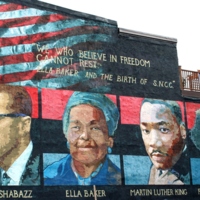
Freedom School
In 2002, with support from the Freedom School Mural Arts Project, Parris Stancell created a mural in West Philadelphia titled Freedom School. The mural sets the faces of Malcolm X, Ella Baker, Martin Luther King Jr., and Frederick Douglass against the backdrop of the American and Black Liberation flags. It depicts Douglass in his younger years, and refers to Malcolm X as Malcolm Shabazz – a composite of his names in the latter years of his life; Malcolm X and el-Hajj Malik el-Shabazz. The mural also champions women's activiism through Ella Baker’s quotation, “We who believe in freedom cannot rest.”
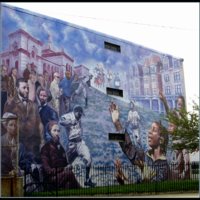
Leidy School Mural
John Lewis and Delia King’s Leidy School Mural is in West Phildelphia. Painted in 2004, the mural fuses history with contemporary scenes of children playing. The young African American children to the right-hand side of the mural are positioned inwards, absorbing the history of their city. The antislavery leader, Frederick Douglass, looks out to the viewer.
![Anonymous, West 116th Street at 8th Ave, Harlem, NYC, 2007 [destroyed].jpg Anonymous, West 116th Street at 8th Ave, Harlem, NYC, 2007 [destroyed].jpg](https://486312.frmmmguz.asia/files/square_thumbnails/68ba2c99969cfee543cc2473ef6ae0da.jpg)
If There is No Struggle
This mural was painted by an anonymous artist around 2007 and no longer exists, but is an important example of both the ephemeral and guerrilla nature of murals: some last for short periods of time on buildings and streets in communities. This particular mural was created in West Harlem and focused on the abolitionist Frederick Douglass. Borrowing his famous phrase from 1857, “If there is no struggle, there is no progress,” the muralist also adds a drumming figure to the centre of the mural.
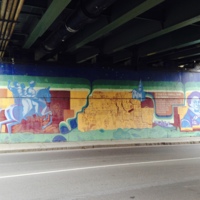
Tubman and Douglass
In 2010 the Brooklyn-based muralist Jonathan Matas created a mural on Green Street in Ithaca under the Aurora Street Bridge. The 30 x 600 foot mural was approved by the Public Arts Commission and depicts Frederick Douglass and Harriet Tubman. “I think it’s a great introduction to our city,” Ithaca Planning and Development Director JoAnn Cornish said. But this was not the general consensus around the mural. The name, 'Comrade Tubman' given to Harriet Tubman on the mural has been a point of controversy for the local community. Tompkins County historian and author Carol Kammen observed: “The word comrade is historically inappropriate and anachronistic."
![Marianne DiNapoli-Mylet, Looking Back, A History of the Black Press, 617 Liberty Street [Chronicle building], Winston-Salem, NC, 1998.jpg Marianne DiNapoli-Mylet, Looking Back, A History of the Black Press, 617 Liberty Street [Chronicle building], Winston-Salem, NC, 1998.jpg](https://486312.frmmmguz.asia/files/square_thumbnails/e0cc2766c734172616139639b01f1af0.jpg)
Looking Back, A History of the Black Press
In 1998, Ernie Pitt, the editor of the Winston-Salem Chronicle, requested a mural that depicted the black press in the United States. Responding to his request, muralist Marianna DiNapoli-Mylet, created Looking Back, A History of the Black Press on the Winston-Salem Chronicle building, In the mural, she shows the history of the black press from 1700 through to the 1960s. The mural features Frederick Douglass most prominently in the centre, with other individuals including W.E.B. Du Bois on the periphery.
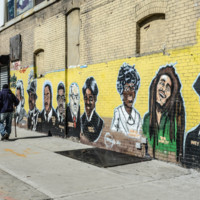
Bed-Stuy Mural
In 2009, the NYC Justice Corps created a mural on Nostrand Avenue and Herkimer Street in Bedford-Stuyvesant, Brooklyn. The NYC Justice Corps was created as part of the city’s strategy to combat poverty and has the mission to “develop the capacity of neighborhoods to address the reintegration challenges of their young adults re-entering from the criminal justice system, and to instil in those young adults a sense of civic responsibility and accountability.”The mural includes the faces of Marcus Garvey, Martin Luther King Jr., Thurgood Marshall, Harriet Tubman, Malcolm X, Shirley Chisholm, Bob Marley and Huey P. Newton, as well as the antislavery figures Harriet Tubman and Frederick Douglass.
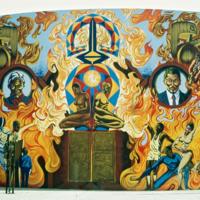
The Fire Next Time I
Dewey Crumpler is an influential black muralist whose work is largely situated in San Francisco. In 1977, after finishing a series of murals at the George Washington High School in San Francisco, the muralist embarked upon two major projects titled The Fire Next Time I and The Fire Next Time II. For the first mural, Crumpler focused on the relationship between African and African American culture. Located at the Joseph Lee Recreation Center in Hunter’s Point-Bayview, the Fire Next Time I deals with education, culture and religion for African Americans. It moves back and forth between the figures of a teacher and a student, Harriet Tubman, Paul Robeson, and two mythical beings in African folk-lore – the Senufo birds.When Crumpler was painting the mural on Oakdale Avenue and Mendell Street in 1977, a local resident approached him and asked about the figures. Upon hearing about Tubman and Robseon, the resident responded: “They don’t live here, man. You should put up a couple of locals like Richard and Edwina. They’re a stone couple.” But a few weeks later, the resident returned and told Crumpler he was right: “black people needed to know more about important leaders so they could have somebody to respect, and besides, Richard and Edwina had broken up.” The mural also faced backlash from a local church group, because of the nude figures at the midpoint.
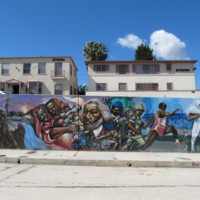
The Crenshaw Wall
In 2000, a graffiti collective called Rocking The Nation (RTN) began The Crenshaw Wall, colloquially known as The Great Wall of Crenshaw. At 7,787 feet long, the mural has become a landmark for the area. The timeline depicts African American history, and features the antislavery figures Frederick Douglass and Harriet Tubman, as well as Marcus Garvey, black soldiers from World War I, II and Vietnam, and Ethiopia’s Emperor Haile Selassie. A shackled slave breaks free from his chains and evolves into an athlete, American footballer and basketball player. Further along the mural are Black Panther Party leaders alongside Martin Luther King Jr., and Malcolm X. The mural starts with a black woman breathing life into the mural and ends with a couple giving birth.“We finally get the chance to paint the Crenshaw Wall, and bring some black awareness to the Crenshaw Wall – to teach the history of our people, to teach our people to be proud, to teach our people love, and where we came from and where we might possibly end up,” explained Enk One of RTN.Over a decade later, the mural requires restoration and protection. RTN are working towards this goal, as well as designating the mural a historical landmark, renaming the block ‘Crenshaw Mural Square’ and developing an app that gives a visual tour of the mural.
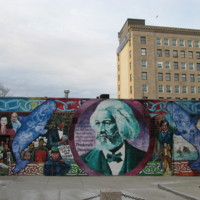
Labor History Mural
This mural in New Bedford titled Labor History Mural and painted by Irish muralist, Dan Devenny, is a short distance away from where Frederick Douglass first lived in freedom. It is on a wall near the Bristol County Probate Court.On September 18, 1838, Douglass settled here in New Bedford after escaping from slavery in Maryland, with the help of his soon-to-be wife, Anna Murray. It was in New Bedford where Douglass experienced, for the first time, what it was like to live as a free man. His abolitionist identity started to take shape. He read his first copy of The Liberator, became a licensed preacher, gave a speech in 1839 that denounced the proposal that free slaves be forced to emigrate back to Africa, and was hired as an agent by the Massachusetts Anti-Slavery Society (MASS). In 1841, after attending a regional convention for the followers of William Lloyd Garrison, Douglass felt compelled to speak about his time in bondage. Inspiring the Garrisonian audience, he was shortly recruited as a lecturer for MASS. “Many students in New Bedford never learn of the importance of Frederick Douglass and his relation to the civil rights movement and this city,” said Massachusetts Senator Mark Montigny. “This mural will be a constant reminder of his prominent leadership and what he means to New Bedford.”
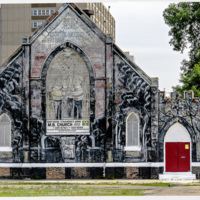
All of Mankind (Why Were They Martyred?)
In 1972, a pioneer of the Chicago mural movement, William Walker, painted a mural on Strangers Home Missionary Baptist Church that was both a rallying call for social justice and a symbol of love and unity. Painted in an era of social revolution, and radical in its day, the inclusionary mural incorporated the names of individuals such as Jesus, Gandhi, Malcolm X, Martin Luther King Jr., and Anne Frank. Further down the murals are the martyrs of the Civil Rights and Black Power movements – names such as Medgar Evers, Mrs. Liuzzo, Fred Hampton, Mark Clark and Emmett Till. In December 2015, All of Mankind was suddenly destroyed. Jon Pounds, executive director of the Chicago Public Art Group (formerly known as the Chicago Mural Group), commented that the mural was a rare remnant of the civil rights era. He knew it was under threat when the church went up for sale in 2011, but preservationists had tried to protect the mural.
![Mary Patten, Douglass Street Mural, 389 Douglass St, Brooklyn, NY, 1976 [destroyed 1989].jpg Mary Patten, Douglass Street Mural, 389 Douglass St, Brooklyn, NY, 1976 [destroyed 1989].jpg](https://486312.frmmmguz.asia/files/square_thumbnails/95232a9ffb9e9bde28fc73b69fc9109a.jpg)
Douglass Street Mural
Mary Patten painted Douglass Street Mural – Cityarts Workshop’s first Brooklyn-based project – in 1976. Over a five-month period, Patten led a group of 20 teens and adults to develop various themes for the mural that would be located on Douglass Street in the Park Slope area of Brooklyn - an area more commercial than residential at the time. Community meetings and bilingual flyers filled the neighbourhood in the hope of garnering community input and consensus over the choice of imagery. The three-storey mural takes advantage of the building's structure by presenting the image as book pages waiting to be read. The dystopian nightmare to the right-hand side of the mural attempts to encroach on the multicultural utopian melting pot to the left, only to be fended off by workers and important figures from U.S. history. Folded into the Puerto Rican flag and the red, white and green banner of the African National Congress, are the images of Harriet Tubman, pointing towards the nightmare-scape, alongside Frederick Douglass, Lolita Lebrón, Malcolm X and H. Rap Brown. Under the imperialist eagle and puppet-like figure in its talons, Patten depicts a recent firebombing that had destroyed the homes of several Black families a few blocks away. Speaking of the large rainbow in the image, the muralist incorporated it to show "what is possible when people work and fight together to create what we need: a community school that provides quality education; people sharing skills and tools; dancing together; making music and painting a mural."The mural sought to convey hope and determination in the face of oppression. But by the 1980s, the mural had become obscured by new housing developments.
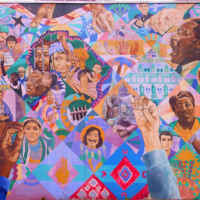
Freedom Quilt Mural
In 1988 David Fichter, with the help of volunteers, painted the Freedom Quilt Mural on the side of the American Friends Service Committee Building in Atlanta, Georgia. The mural was created as part of the Rainbow Coalition events during the 1988 Democratic National Convention. In February 2015 the building, owned by Georgia State University, was torn down – taking the mural with it. The quilted mural is thematically focused on non-violent heroes of history that struggled for justice and peace. It includes the faces of Mubarak Awad, Nelson Mandela, Winnie Mandela, Desmond Tutu, Oscar Romero, Rogoberta Menchu, Leonard Peltier, Andrew Goodman, Fannie Lou Hamer, Daniel Berrigan, Martin Luther King Jr., Rosa Parks, Mahatma Gandhi, and Lucretia Mott. It also includes the antislavery figures of Frederick Douglass and Harriet Tubman. Tubman points towards the North Star. Multi-racial hands stitch the quilt together, joining heroes (both famous and unknown) from all strands of history.
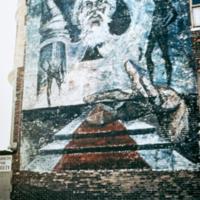
Frederick Douglass
Muralist Al Smith painted the abolitionist Frederick Douglass as a mythic elder statesmen for this Boston mural. Douglass had visited Boston exactly 80 years, from May 28-31, 1888, when he attended the annual convention of the New England Woman Suffrage Association and delivered an address on Women’s Rights at Tremont Temple. “My special mission in the world, if I ever had any,” Douglass told his audience, “was the emancipation of enfranchisement of the negro. Mine was a great cause. Yours is a much greater cause since it comprehends the liberation and elevation of one-half of the whole human family.”
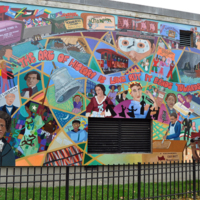
The Arc of History is Long
The muralist David Fichter adapted Martin Luther King Jr.’s famous quotation “the arc of the moral universe is long but it bends towards freedom,” for this 2002 mural in Cambridge, Massachusetts. The mural features Susan B. Anthony, Rosie the Riveter, William Lloyd Garrison and W.E.B. Du Bois, as well as a young Frederick Douglass.At around the same age as he appears in this mural, Douglass gave a speech in nearby Boston on February 8, 1855 where he drew attention to the psychological impact of enslavement: “Whipping is not what constitutes the cruelty of Slavery," explained Douglass. “To me the thought that I am a slave is more terrible than any lash, than any chain.”
![Anonymous, W Florence & S Western Aves, South-Central LA (Black Neighborhood), 1999 [destroyed].jpg Anonymous, W Florence & S Western Aves, South-Central LA (Black Neighborhood), 1999 [destroyed].jpg](https://486312.frmmmguz.asia/files/square_thumbnails/7fabdee3546a6cb70ee280e97b7dd315.jpg)
Martin Luther King Jr., Malcolm X and Frederick Douglass
This mural of Martin Luther King Jr., Malcolm X and the abolitionist Frederick Douglass appeared in south-central LA in 1999 and had been destoyed by 2010.
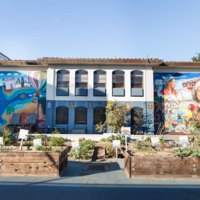
Now and Then
In 1996, the Rafael Elementary School in San Francisco changed its name to Rosa Parks Elementary School, and the San Francisco School Board president commissioned a mural to mark the new name. The mural was a community effort by students from the Art Institute, the Academy of Art and San Francisco State University. It aimed to make children aware of Rosa Parks. Once the mural was finished, Parks herself came to unveil it. Also included on the wall are the antislavery figures Harriet Tubman and Frederick Douglass, as well as Thurgood Marshal and W.E.B. Du Bois.
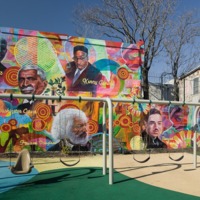
The Faces That Shape Us
On May 25, 2011, a mural titled The Faces That Shape Us, was dedicated in Uncle David’s Playground. Mr Kenneth Gamble (pictured on the mural), the founder and chairman of Universal Companies, had bought a rundown building in South Philadelphia and tore it down. He wanted to bring something positive to the neighbourhood and so he funded a local children’s playground, complete with a mural. Muralists Keir Johnston and Ernel Martinez started the mural in the summer of 2010. The mural features Frederick Douglass and other historical figures such as W.E.B. Du Bois, George Washington Carver and James Baldwin, as well as local figures Dr. Emmett Chapell, Judge Frederica Jackson, and Faatimah Gamble. The mural was developed through a partnership with Universal Companies, the Philadelphia Prison System and the City of Philadelphia Department of Human Services.
![Curtis Lewis, African Amalgamation of Ubiquity, 9980 Gratiot Avenue, Detroit, Michigan, 1985 [destroyed in 2013].jpg Curtis Lewis, African Amalgamation of Ubiquity, 9980 Gratiot Avenue, Detroit, Michigan, 1985 [destroyed in 2013].jpg](https://486312.frmmmguz.asia/files/square_thumbnails/3ac63b31ad894031e7c74b99651ace4a.jpg)
African Amalgamation of Ubiquity
In 1985, muralist Curtis Lewis created a mural on the side of a drug rehabilitation centre on Gratiot Avenue, Detroit, Michigan. The building belonged to Operation Get Down and included the antislavery figures Frederick Douglass and Harriet Tubman, as well as Malcolm X, Mary McLeod Bethune, Jesse Jackson, Thurgood Marshall, Martin Luther King Jr., W.E.B. Du Bois, Booker T. Washington, Ida B. Wells, Marcus Garvey and Nelson Mandela, alongisde Egyptian, Nubian and pharaoh figures. The man who breaks free of his chains in the centre of the mural holds a sign that reads, “Behold my people, arise, stand strong and proud, for ye come from pharaohs, emperors, kings and queens.” The mural was destroyed in 2013.